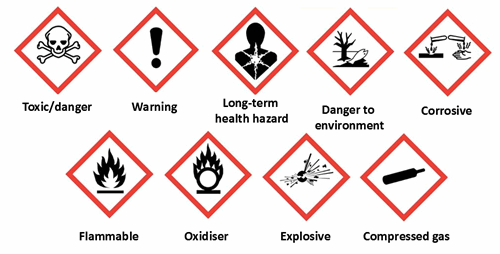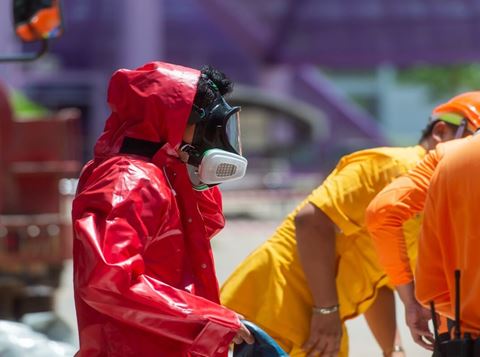What does COSHH mean?
COSHH stands for 'Control of Substances Hazardous to Health'. COSHH is a set of regulations put in place to protect workers from ill health when working with specific substances and materials.
Breach of COSHH regulations by an employer or employee is a crime, punishable by an unlimited fine.
COSHH was introduced to control the exposure of a business’ employees to hazardous substances. A COSHH assessment concentrates on the hazards and risks from substances in a workplace and asks questions such as:
- Where is there potential for exposure to substances that might be hazardous to health?
- In what way are the substances harmful to health?
- What jobs or tasks lead to exposure?
- Are there any areas of concern?
The COSHH regulations have been in place for more than 25 years, but the most recent iteration (2002) were re-enacted with amendments of the Control of Substances Hazardous to Work Regulations 1999.
What does COSHH cover?
The ‘substances’ part of COSHH includes any form of hazardous material, including liquids, solids, fumes, dust, vapours, fibres, nano-particles, mists, gases and biological agents such as bacteria and viruses. The ‘hazardous’ part includes damage to lungs, skin, nose, mouth, genes, internal organs, eyes or central nervous system as well as the risk of injury due to combustion or explosion.
Millions of people work in environments that bring them into proximity of hazardous substances, and the effects of mismanagement, poor safety and accidents can be fatal: 144 people were fatally injured at work in 2017/8. Exposure to harmful working conditions can also result in fatal diseases - such as asbestosis - which claim the lives of 13,000 people per year. Hazardous chemicals can also cause injury (541,000 workplace injuries were reported in 2017/8) and ill health (1.4 million workers suffer from work-related ill health. Non-stress or musculoskeletal disorders make up 56% of those). For example, there are 7,000 new cases of self-reported work-related skin problems.
There are many workplaces that have obvious risks - quarries, mines, metal finishers, woodworking and plastics factories - but there are many more that are less obvious such as cleaners, construction, automotive industry and even food preparation.
Workplaces must provide information/training and equipment to mitigate risk and injury, and employees must ensure they follow protocols. This often includes formal training - including the COSHH training course. The full responsibilities of both parties are listed below.
While the human cost is of primary concern, the cost to business is also huge, with 30.7 million working days lost in 2017/8 and a cost of £5.2bn due to workplace injury in 2016/7.
By following the COSHH Regulations, companies can save money and be more effective by reducing absenteeism and not having to replace trained workers. A healthy workforce means a healthy bottom line.
The best way to get a full understanding of what is and isn't covered by COSHH is to undergo appropriate training.
COSHH employer responsibilities
Employers have a number of key responsibilities regarding COSHH laws. These include:
- Exposure - Employers must prevent or control exposure to hazardous substances. This can include the provision of appropriate personal protective equipment (PPE) where necessary
- Control measures - Implement control measures around hazardous substances and ensure these are maintained and kept up to date, in full working order and clean where appropriate
- Instruction - Provide employees with information, instruction and training around working with hazardous substances
- Procedures - Having procedures in place to deal with accidents and emergencies relating to hazardous substances
- Surveillance - Ensure employees exposed to hazardous substances are under adequate surveillance
- Risk assessments - Carry out COSHH risk assessments.
- Limits - Ensure the use of hazardous substances doesn't exceed the Workplace Exposure Limit (WEL).
- Supervision - Check employees are carrying out tasks as they are supposed to.
Employee responsibilities
Employees have the responsibility to ensure that tasks are carried out safely to ensure no harm comes to themselves or others. These include:
- Safety - Assist their fellow employees in creating a safe working environment. This can include supporting colleagues to abide by the regulations specific to their workplace
- Procedures - Follow the procedures put in place to stop accidents and overexposure
- PPE (personal protective equipment) - Wear the correct PPE including eye and noise protection. This includes ensuring all PPE is stored correctly in the appropriate place
- Reporting - Report and record all accident, spillages and breakages
- Check-ups - Attend medical check-ups when required to
- Cleaning - Use cleaning and showering facilities provided by employers in line with official procedures
- Training - Keep up to date with training provided by employers.
What are the COSHH symbols and their meanings?
There are nine primary hazard symbols relating to COSHH and this section will explain the COSHH signs.

While some of these signs and symbols are self-explanatory or have obvious meanings, others deserve more explanation:
- Dangerous to the environment - Chemicals that may present an immediate or delayed danger to aspects of the environment – wildlife, plant life, people, weather systems.
- Toxic - Chemicals that at low levels cause damage to health. When the sign includes a T+ in the top left-hand corner, it means chemicals that can cause damage to health at very low levels.
- Oxidising - Chemicals and preparations that react exothermically with other chemicals – often resulting in combustion. Common oxidizing agents are oxygen, hydrogen peroxide and the halogens.
- Corrosive - Substances that can damage or destroy other substances with which it comes into contact by means of a chemical reaction. These can exist as any state of matter, including liquids, solids, gases, mists and vapours.
- Longer-term health hazards - This sign indicates the presence of a cancer-causing (carcinogenic) agent or substance with respiratory, reproductive or organ toxicity that causes damage over time (a chronic, or long-term, health hazard).
- Caution - Caution relates to slightly less hazardous substances that may not pose an immediate or severe threat to health but should be handled carefully within the workplace.
Make sure you’re COSHH compliant by taking COSHH training courses to ensure you and your employees work safely.
What COSHH training is available?
We currently over two COSH training courses:
British Safety Council Certificate in COSHH Risk Assessment
This qualification delivers essential knowledge and understanding of the Control of Substances Hazardous to Health (COSHH).
Working with Hazardous Substances
This short online course highlights the risks associated with hazardous substances and how to reduce those risks.



